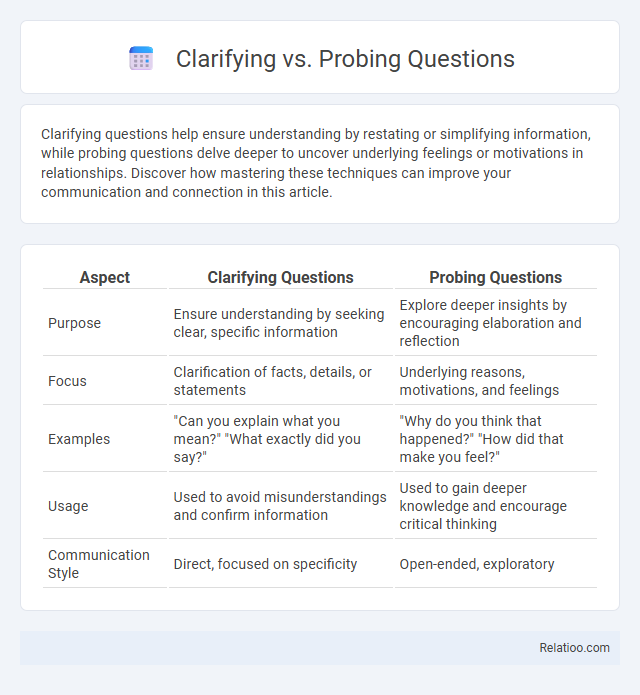Clarifying questions help ensure understanding by restating or simplifying information, while probing questions delve deeper to uncover underlying feelings or motivations in relationships. Discover how mastering these techniques can improve your communication and connection in this article.
Table of Comparison
| Aspect | Clarifying Questions | Probing Questions |
|---|---|---|
| Purpose | Ensure understanding by seeking clear, specific information | Explore deeper insights by encouraging elaboration and reflection |
| Focus | Clarification of facts, details, or statements | Underlying reasons, motivations, and feelings |
| Examples | "Can you explain what you mean?" "What exactly did you say?" | "Why do you think that happened?" "How did that make you feel?" |
| Usage | Used to avoid misunderstandings and confirm information | Used to gain deeper knowledge and encourage critical thinking |
| Communication Style | Direct, focused on specificity | Open-ended, exploratory |
Understanding Clarifying and Probing Questions
Clarifying questions aim to ensure clear understanding by asking for more details or examples related to the initial statement. Probing questions dig deeper into underlying reasons, motivations, or causes to uncover additional insights. Your effective use of both types enhances communication accuracy and depth in conversations.
Defining Clarifying Questions
Clarifying questions are designed to ensure understanding by requesting more precise information or elaboration, helping to remove ambiguity from a conversation. Defining clarifying questions specifically target the meaning or definition of a term or concept, enabling You to grasp the exact intent and context. Probing questions, in contrast, dig deeper to uncover underlying reasons or motivations beyond the initial information provided.
Defining Probing Questions
Probing questions are designed to dig deeper into a topic, encouraging detailed responses and uncovering underlying motivations or issues. Unlike clarifying questions that seek to clear up confusion or confirm understanding, probing questions push beyond surface-level information to gain insight into complex thoughts or emotions. Your use of probing questions enhances communication by eliciting richer and more comprehensive explanations.
Key Differences Between Clarifying and Probing Questions
Clarifying questions seek to ensure understanding by requesting specific details or examples, aiming to eliminate ambiguity in conversations or instructions. Probing questions delve deeper into underlying reasons, motivations, or causes, encouraging critical thinking and expanded insight beyond the initial responses. You should use clarifying questions to confirm precise information, while probing questions help uncover more comprehensive explanations and broader perspectives.
When to Use Clarifying Questions
Clarifying questions are essential when you need to ensure your understanding of specific details, eliminating ambiguity in communication. Use clarifying questions when information is vague, incomplete, or when you want to confirm facts, ensuring your interpretation aligns with the speaker's intent. Your ability to ask precise clarifying questions enhances effective communication and decision-making in professional and personal interactions.
When to Use Probing Questions
Clarifying questions help confirm understanding by requesting specific information or repetition, while probing questions are used to explore deeper insights, motivations, or underlying causes behind a response. When to use probing questions is crucial in situations where you need to uncover hidden details, challenge assumptions, or encourage elaboration beyond surface-level answers. To enhance your communication, use probing questions when seeking to resolve ambiguities, stimulate critical thinking, or drive problem-solving in complex scenarios.
Examples of Effective Clarifying Questions
Effective clarifying questions help you gain precise understanding by asking for specific information or examples, such as "Can you elaborate on the challenges you faced during the project?" or "What do you mean by 'increased efficiency' in this context?" Probing questions, on the other hand, dig deeper into underlying reasons or feelings, like "Why do you think the strategy didn't work as expected?" Clarifying questions ensure you avoid misunderstandings and stay aligned with your conversation partner's intent.
Examples of Effective Probing Questions
Effective probing questions such as "Can you elaborate on the challenges you faced during the project?" and "What specific factors influenced your decision-making process?" encourage detailed responses and deeper understanding. Unlike clarifying questions that seek to confirm facts or clarify ambiguous information, probing questions aim to uncover underlying motives, assumptions, or insights often missed in surface-level answers. Examples like "How did that outcome impact your team's goals?" and "What alternative solutions did you consider before choosing this approach?" demonstrate how probing questions drive more comprehensive exploration.
Common Mistakes in Asking Questions
Common mistakes in asking clarifying questions include being too vague or asking multiple questions at once, which can confuse the person responding and hinder understanding. Probing questions often fail when they are overly aggressive or irrelevant, causing defensiveness or disengagement. You can improve communication by focusing on clear, specific clarifying questions that seek to confirm understanding without assumptions.
Enhancing Communication Skills with the Right Questions
Clarifying questions are designed to ensure understanding by requesting specific information or rephrasing statements, while probing questions dig deeper to explore underlying reasons, feelings, or motivations. Enhancing communication skills involves knowing when to use clarifying questions to confirm accuracy and probing questions to gather comprehensive insights. Mastering the balance between these question types improves active listening, reduces misunderstandings, and fosters more meaningful dialogue.

Infographic: Clarifying vs Probing Questions
 relatioo.com
relatioo.com